What diseases do sweet peppers have: methods of combating them and photos of leaves
Sweet peppers are planted by gardeners all over the country. In order to harvest a rich harvest from the site, preventive measures are taken against diseases. If the plant is already sick, immediate action must be taken. The causes of infection are different: climate, improper care, acidic soil. The article will tell you what sweet pepper diseases are and how to deal with them.
How to tell if a pepper is sick
Recognize disease by external signs. With some diseases, the bushes curl and turn yellow, while with others, the leaves become dry and covered with dark spots. The fruits become sluggish, lose their elasticity and shape. With some diseases, peppers become covered with ulcers and the stem darkens.
In order to detect disease symptoms in time, it is recommended to inspect the beds daily. When first detected, gardeners immediately take remedial measures.
Reasons why peppers can get sick
The causes of diseases are conventionally divided into several groups. Let's look at each of them in detail and identify the distinctive features:
- Climatic reasons: drought or heat, rain or sudden changes in weather. For example, fungal diseases spread quickly in rainy and hot summers, while viral diseases spread quickly in any weather. To prevent disease, it is recommended to choose a pepper variety based on the characteristics of the region.
- Agrotechnical: increased acidity of the soil, lack of necessary minerals and other nutrients in the ground, groundwater located near the beds. All this leads to the fact that the plant does not have enough strength to develop. The immune system weakens, causing bell peppers to get sick. Gardeners advise planting the vegetable on a mixture of loamy and sandy loam soils located in hilly, spacious and sunny beds.
- Improper care: lack or excessive amount of watering, lack or excess of organic and mineral fertilizing. Peppers also get sick from lack of loosening and weeding. To reap a healthy and rich harvest, it is recommended to water the beds every five days and use warm water for watering. Fertilize the soil once every 10 days.
Sweet pepper diseases
Bell pepper diseases are divided into several groups - fungal, bacterial, viral and non-infectious diseases. They differ in symptoms, causes of infection, and consequences. Let's take a closer look at each group and photos of common diseases.
Fungal
Fungal diseases are typical for regions with hot and humid summers. Most often they appear in greenhouses or greenhouses. Fungal spores develop quickly due to excessive watering, penetrate into the plant and disrupt the metabolism of peppers. Spores live up to 10 years and are carried by wind, insects or the remains of other plants.
The most common fungal diseases:
- Blackleg appears on young seedlings or mature fruits. The causative agents are fungal spores; they live in the upper layers of the soil and live off organic residues. Thickened planting, humidity, and lack of mineral nutrition lead to blackleg.To combat the disease, a solution of Bordeaux mixture is used - 80 ml of the drug is used per 10 liters of water. About 0.5 liters of solution is poured onto one plant. Bordeaux solution is also used as a prophylactic agent. Before doing this, be sure to wear a respirator, safety glasses and gloves.
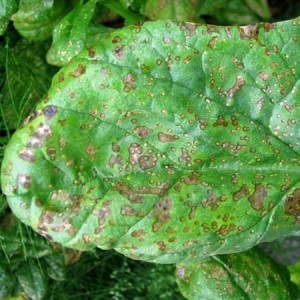 Gray rot appears as light watery spots on the fruit. The disease is caused by: acidic soil, lack of fertilizers, weeds. If measures are not taken in time, the peppers will spoil and become moldy. At this stage, the plants cannot be treated - the bushes are removed from the garden bed and burned. To avoid gray rot, gardeners spray the beds with a solution based on dry wood ash (take 60 g of ash per 1 liter of water).
Gray rot appears as light watery spots on the fruit. The disease is caused by: acidic soil, lack of fertilizers, weeds. If measures are not taken in time, the peppers will spoil and become moldy. At this stage, the plants cannot be treated - the bushes are removed from the garden bed and burned. To avoid gray rot, gardeners spray the beds with a solution based on dry wood ash (take 60 g of ash per 1 liter of water).- Late blight is one of the most common fungal infections of greenhouse peppers. Late blight fungus appears on peppers during periods of rain, fog and temperature changes. The leaves become covered with dark spots, dry out and wither, the stalk becomes watery. After a few days, the fruits become deformed and lose their taste. Infected plants are removed from the garden bed and burned; the remaining peppers are sprayed with Fitosporin or Previkur. For 2 liters of water use 3 ml of the drug, consumption - 2 liters per 1 sq. m of land. Photos of leaves affected by late blight are below.
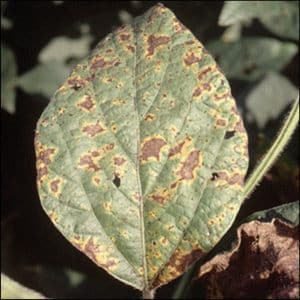 Cladosporiosis appears in greenhouses and in open ground. The fungus gets into the beds with plant debris, weeds or together with gardening tools. Brown spots appear on the inside of the leaf, gray or black on the outside. If treatment is not carried out in time, the peppers die. For treatment, use a solution of copper sulfate - 10 ml per 1 liter of water. The bushes are sprayed in the morning or evening, consumption - 1 liter per 1 sq. m.
Cladosporiosis appears in greenhouses and in open ground. The fungus gets into the beds with plant debris, weeds or together with gardening tools. Brown spots appear on the inside of the leaf, gray or black on the outside. If treatment is not carried out in time, the peppers die. For treatment, use a solution of copper sulfate - 10 ml per 1 liter of water. The bushes are sprayed in the morning or evening, consumption - 1 liter per 1 sq. m.
Bacterial
Sources of bacterial diseases are animals, plants, and insect pests. Therefore, it is important to maintain the microflora of the beds and properly and regularly care for the plants.
Bacterial diseases include the following:
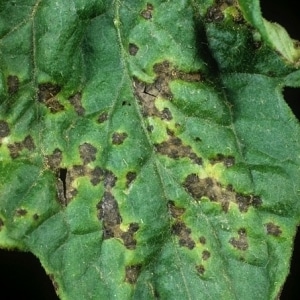
- Black spot. Bacteria actively develop with a lack of potassium or iron, during prolonged rains and fogs. Leaves and fruits become covered with dark watery spots. It is useless to treat black spot - infected plants are removed. As a preventive measure, spraying with milk with iodine is used - 30 ml of milk and 10 ml of iodine are required for 1 liter of water. Such spraying strengthens the pepper's immunity.
- Lightning withering. The bacteria penetrate the stem and quickly spread throughout the plant. White mucus appears in the stem, which interferes with the access of nutrients to the fruit. The affected bushes are removed; for prevention, the drug “HOM” or a solution of Bordeaux mixture is used. Peppers are sprayed or watered with these products, per 1 square meter. m use about 1 liter.
- Bacterial rot It affects peppers at any stage - it can be seedlings or already harvested fruits. Watery spots appear on peppers, which increase in size over time. As a preventative measure, it is recommended to weed the beds and remove weeds once a week, water plants with water at room temperature. In case of infection, the fruits are thrown out and the bushes are eliminated from the garden.
- Bacterial cancer - a local disease of pepper fruits that affects plants in open ground. Bacteria persist in the soil and on plant debris; infection often occurs through seed material. The fruits become covered with a large white coating, become deformed and become soft, and begin to taste bitter. Bacterial cancer cannot be treated, so gardeners follow preventive measures: remove weeds, follow the watering regime and fertilizing.
Viral
Pathogens are viruses that live in plant cells.
Reference. Infected plants begin to die off piece by piece: the viruses first infect the leaves, then spread to the stem and petioles.
The most dangerous viral diseases:
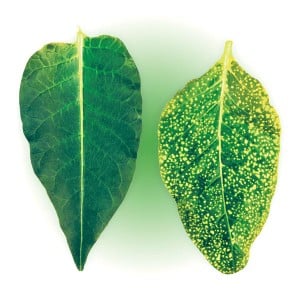
- Tobacco mosaic appears due to low lighting and high air humidity, typical for greenhouse peppers. Infection with the virus occurs through soil or seed, so it is important to disinfect before planting. Yellow spots appear on the leaves in the form of a mosaic, over time they darken and the foliage falls off. For therapeutic and preventive purposes, spraying with a milk solution is used (for 10 liters of water, take 1 liter of milk and 5 ml of iodine).
- Cucumber mosaic manifests itself in the form of deformation of plants. The virus is transmitted through aphids or other insect pests. There are several varieties of cucumber mosaic: yellow, brown, transient, dwarf. They differ in symptoms and consequences. The virus is common in regions with low temperatures, short daylight hours and fog. Mosaic is treated with the drug “Quadris”. Plants are sprayed, consumption - 400 ml per 1 sq.m.
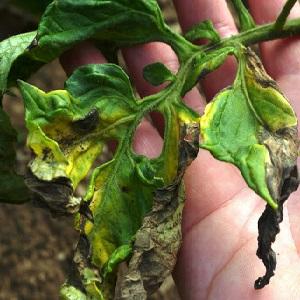 Streak. Dark areas appear in the upper part of the plant. The leaves and stem become brittle and brittle. Growth stops and the fruits wither. Streak appears in areas with clay and acidic soils; rains contribute to the rapid development of the virus. To combat streaks, sodium salt is used. For 1 liter of water use 100 g of a 15% solution. Before spraying, the affected leaves and fruits are removed.
Streak. Dark areas appear in the upper part of the plant. The leaves and stem become brittle and brittle. Growth stops and the fruits wither. Streak appears in areas with clay and acidic soils; rains contribute to the rapid development of the virus. To combat streaks, sodium salt is used. For 1 liter of water use 100 g of a 15% solution. Before spraying, the affected leaves and fruits are removed.- Internal necrosis of fruits. The fruits become covered with dark brown spots and lose their taste. Necrosis is one of the common diseases of indoor pepper. The bushes become deformed and dark ulcers appear. For medicinal and preventive purposes, watering with a solution of potassium permanganate is used - 10 g per 1 liter of water.
Non-infectious
Non-infectious problems cause less harm to peppers than viral, bacterial or fungal ones. They are easier to treat and arise for various reasons:
- An excess of nitrogen leads to an increase in green mass. The leaves become fluffy and large, and the fruits themselves stop growing. It is recommended to use nitrogen fertilizing at the stage growing seedlings, an adult plant does not require it in large quantities.
- The development of bell peppers is also negatively affected by a lack of nitrogen-containing fertilizers - the bush stops growing, the leaves and stem become weak and fragile, the fruits slowly gain weight and color.
- A lack of potassium leads to yellowing of the leaves, a lack of phosphorus leads to slow development of the root system and a purple color of the fruit. If a plant lacks boron, it drops its leaves.
For balanced nutrition and disease prevention, gardeners alternate mineral and organic fertilizers.
Important! Feed sweet peppers once every 10-15 days, after watering the beds. Organic ingredients include nettle infusion, milk solution, and onion peel.
Prevention measures
The best way to avoid treating plants is to take preventive measures in time. They will strengthen the pepper’s immunity and make the fruits more healthy and tasty.
Gardeners recommend:
- Plant peppers using seedling method. To do this, disinfect the seeds with a solution of potassium permanganate, purchase a special seedling container and etch the soil. The seedlings are watered and fertilized, kept in warm and sunny light. Peppers planted in seedlings suffer less disease and are characterized by rapid and consistent fruiting.
- Choose a variety based on the climatic conditions of the region. In some regions, varieties that are resistant to sudden weather changes are chosen: Atlant, Funtik, Accord; in others, any peppers are planted - the warm and temperate climate allows this. It is recommended to read the planting guidelines on the packaging.
- Disinfect the beds before planting — remove weeds and remains of last year’s plants, dig up the beds. If the soil is acidic, it is recommended to add lime and wood ash.
- Follow the rules of crop rotation - Do not plant peppers in one place for more than three years in a row. The best predecessors for planting are cabbage, carrots, and peas. It is not recommended to plant sweet peppers after potatoes or tomatoes.
- Regularly care for your garden beds: water, fertilize, loosen and weed. If the variety requires it, it is formed into one or two stems. Not only protection from diseases, its taste and quality of pepper depend on proper care.
In the middle zone and in the north, bell peppers are planted in a greenhouse, in the south of the country - in open ground.
Conclusion
Why do peppers get sick? Agronomists identify several reasons: improper care, changeable climate, lack of nutrition. To defeat pepper disease, it is worth studying in advance the symptoms and causes of common diseases and methods of treating them.
To strengthen the immune system and prevent diseases, spraying with Bordeaux mixture or a solution of potassium permanganate is used.For treatment, the drugs “Fitosporin”, “Quadris” or “HOM” are used. It is important to follow the dosage and recommendations for use.